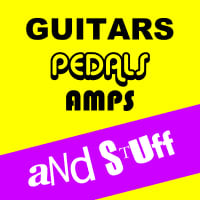Delay is a time-based guitar effect that produces echoes or repetitions of the original signal after a certain amount of time has passed. It works by recording the incoming audio signal and then playing it back with a slight delay, creating the perception of multiple instances of the sound occurring over time. Delay pedals typically offer controls for adjusting parameters such as delay time, feedback (the number of repeats), and level (the volume of the delayed signal). By manipulating these controls, guitarists can create a wide range of delay effects, from subtle ambiance to rhythmic patterns and spacious soundscapes. Delay is commonly used in various music genres, including rock, pop, ambient, and electronic music, to add depth, dimension, and texture to guitar solos, rhythm parts, and atmospheric passages. Popular delay pedal models include the TC Electronic Flashback, Boss DD-7 Digital Delay, and Strymon Timeline.
Electric guitars use magnetic pickups to convert string vibrations into an electrical signal, which is then amplified. Unlike acoustic guitars, they rely on amplification for volume and tone shaping, making them highly versatile in genres like rock, blues, jazz, and metal. Electric guitars come in many body styles—solid, semi-hollow, and hollow—and feature different pickup configurations, neck types, and hardware. From smooth clean tones to aggressive distortion, they offer a wide sonic range, making them the backbone of modern guitar music.
Reverb, short for reverberation, is an essential guitar effect that simulates the natural reflections of sound in a physical space, such as a room, hall, or cathedral. It adds depth, ambiance, and spaciousness to the guitar’s sound by creating a series of discrete echoes that decay over time, mimicking the way sound reverberates in different environments. Reverb pedals offer controls for adjusting parameters such as decay time (the length of the reverb tail), pre-delay (the time between the original signal and the onset of the reverb), and mix (the balance between the dry and reverberated signals). By adjusting these parameters, guitarists can achieve a wide range of reverb effects, from subtle room ambience to lush, expansive reverberation. Reverb is widely used across various music genres, including rock, jazz, ambient, and electronic music, to add depth, dimension, and realism to guitar tones, creating a sense of space and immersion in the sound. Popular reverb pedal models include the Strymon BigSky, Boss RV-6, and Electro-Harmonix Holy Grail.
We have new and used EarthQuaker Devices musical equipment available on our website for fast direct delivery from sellers across the UK & Europe.
£209.99
Digital delay & reverb in one pedal – with 1.5 seconds of delay time Independent control over delay and/or reverb effects Flexi-Switch allows for momentary and traditional latching-style switching from a single footswitch All-analog dry signal path Silent soft-touch switching | True Bypass
£276.21 £272.02
4 5/8'' x 2 1/2'' x 2.25'' with knobs Any standard 9 volt DC power supply with a negative centre 2.1mm barrel. No battery option. Depth: Sets reverb intensity Dwell: Adjusts the length and thickness of the decay. Attack: Sets the delay of the pick attack on the wet signal from 30ms-150ms.
£170.82
Delays/Echos/Reverb Effekte Gitarren We emphasise a balanced combination of careful workmanship and selected materials. OUR GOAL – Your satisfaction is our top priority and takes centre stage.




